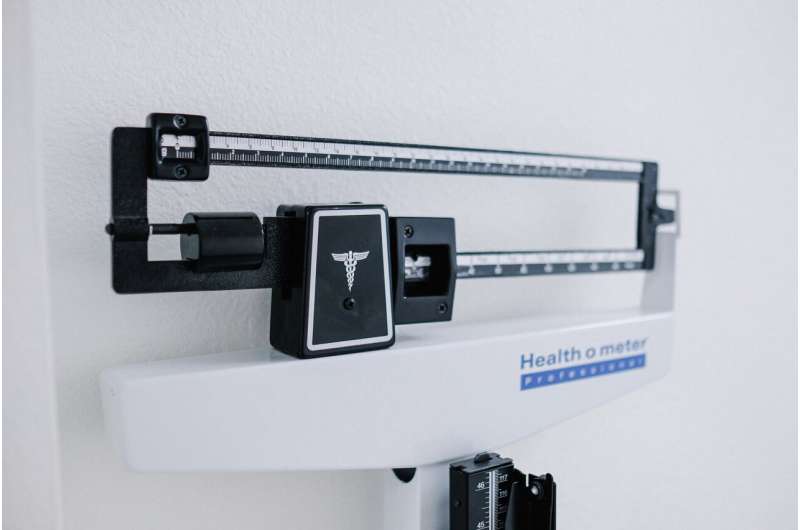This article has been reviewed according to Science X's editorial process and policies. Editors have highlighted the following attributes while ensuring the content's credibility:
fact-checked
trusted source
written by researcher(s)
proofread
The body mass index can't tell us if we're healthy. Here's what we should use instead, says researcher

We've known for some time the body mass index (BMI) is an inaccurate measuring stick for assessing someone's weight and associated health. But it continues to be the go-to tool for medical doctors, population researchers and personal trainers.
Why is such an imperfect tool still being used, and what should we use instead?
First, what is BMI?
BMI is an internationally-recognized screening method for sorting people into one of four weight categories: underweight (BMI less than 18.5), normal weight (18.5 to 24.9), overweight (25.0 to 29.9) or obese (30 or greater).
It's a value calculated by a measure of someone's mass (weight) divided by the square of their height.
Who invented BMI?
Belgian mathematician Lambert Adolphe Jacques Quetelet (1796–1874) devised the BMI in 1832, as a mathematical model to chart the average Western European man's physical characteristics.
It was initially called the Quetelet Index and was never meant to be used as a medical assessment tool. The Quetelex Index was renamed the "body mass index" in 1972.
What's wrong with the BMI?
Using a mathematical formula to give a full picture of someone's health is just not possible.
The BMI does not measure excess body fat, it just measures "excess" weight. It does not distinguish between excess body fat or bone mass or musculature, and does not interpret the distribution of fat (which 'is' a predictor of health, including type 2 diabetes, metabolic disorders, and heart disease).
It also cannot tell the difference between social variables such as sex, age, and ethnicity. Given Quetelet's formula used only Western European men, the findings are not appropriate for many other groups, including non-European ethnicities, post-menopausal women and pregnant women.
The medical profession's over-reliance on BMI may be harming patients' health as it ignores much of what makes us healthy and focuses only on mass.
What should we use instead?
Rather than seeing BMI as the primary diagnostic test for determining a person's health, it should be used in conjunction with other measures and considerations.
Since researchers know belly fat around our vital organs carries the most health risk, waist circumference, waist-to-hip ratio or waist-to-height ratio offer more accurate measurements of health.
Waist circumference: is an effective measure of fat distribution, particularly for athletes who carry less fat and more muscle. It's most useful as a predictor of health when combined with the BMI. Waist circumference should be less than 94cm for men and 80cm for women for optimal health, as measured from halfway between the bottom of your ribs and your hip bones.
Waist-to-hip ratio: calculates the proportion of your body fat and how much is stored on your waist, hips, and buttocks. It's the waist measurement divided by hip measurement and according to the World Health Organization it should be 0.85 or less for women, and 0.9 or less in men to reduce health risks. It's especially beneficial in predicting health outcomes in older people, as the aging process alters the body proportions on which BMI is founded. This is because fat mass increases and muscle mass decreases with age.
Waist-to-height ratio: is height divided by waist circumference, and it's recommended a person's waist circumference be kept at less than half their height. Some studies have found this measure is most strongly correlated with health predictions.
Body composition and body fat percentage can also be calculated through skinfold measurement tests, by assessing specific locations on the body (such as the abdomen, triceps or quadriceps) with skin calipers.
Additional ways to gauge your heart health include asking your doctor to monitor your cholesterol and blood pressure. These more formal tests can be combined with a review of lifestyle, diet, physical activity, and family medical history.
What makes us healthy apart from weight?
A diet including whole grains, low fat protein sources such as fish and legumes, eggs, yogurt, cheese, milk, nuts, seeds, and plenty of fresh fruit and vegetables reduces our risk of heart and vessel disease.
Limiting processed food and sugary snacks, as well as saturated and trans fats can help us with weight management and ward off diet-related illnesses.
Being physically active most days of the week improves general health. This includes two sessions of strength training per week, and 2.5 to five hours of moderate cardio activity or 1.25 to 2.5 hours of vigorous cardio activity.
Weight is just one aspect of health, and there are much better measurements than BMI.
This article is republished from The Conversation under a Creative Commons license. Read the original article.![]()




















